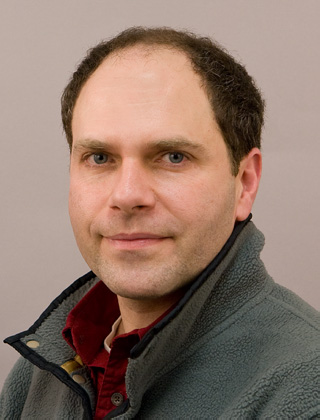
|
Michael Gabbay Senior Principal Physicist gabbay@uw.edu Phone 206-616-8528 |
Biosketch
Dr. Gabbay's current research involves the development of mathematical models and computational simulations of network dynamics, focusing on social and political systems. He has also conducted research in the areas of nonequilibrium pattern formation, coupled oscillator dynamics, sensor development, and data analysis algorithms. His work has appeared in physics, engineering, biology, and political science publications. Dr. Gabbay received a B.A. in physics from Cornell University and a Ph.D. in physics from the University of Chicago with a specialization in nonlinear dynamics.
Education
B.A. Physics, Cornell University, 1985
M.S. Physics, University of Chicago, 1987
Ph.D. Physics, University of Chicago, 1997
|
Publications |
2000-present and while at APL-UW |
Choosing sides in forever wars: How wedge threats shape ideological alignment in fragmented warscapes Gabbay, M., and M.M. Hafez, "Choosing sides in forever wars: How wedge threats shape ideological alignment in fragmented warscapes," Stud. Conflict Terror., EOR, doi:10.1080/1057610X.2024.2398665, 2024. |
More Info |
8 Sep 2024 |
|||||||
|
Fragmented warscapes are characterized by multiple armed groups embracing different primary identities, interests, and ideologies. As conflict conditions evolve, adverse shifts in military capabilities and political standing compel armed groups to seek new allies to halt their decline in power. Instrumentalists assume that ideology is fairly malleable and can shift dramatically to forge new alliances when power considerations demand it, while identity-based theories assume that ideologies are "sticky" and cannot easily accommodate alliances with ideological rivals even under adverse conflict conditions. We attempt to bridge the gap between these two perspectives by proposing a theory in which the distinction between uniform threats and wedge threats helps predict the composition of alliances among ideologically disparate armed groups. When an external threat uniformly challenges the ideological preferences of disparate factions, we anticipate them to form a broad rebel coalition of heterogenous organizations that cooperate despite their ideological differences. Conversely, a wedge threat strains the ideological preferences of some groups more than others, forcing groups to make tradeoffs between alliance partners and ideology, thereby narrowing the ideological diversity of alliances. Methodologically, we apply a novel network approach to insurgent factional realignments in Iraq from 2003 to 2009. This case demonstrates that concern for declining organizational power does not completely override ideological considerations. Iraqi rebel groups that needed new allies to remedy their diminishing power formed alliances with armed factions that shared their highest ideological priorities while giving up other ideological demands that would have hindered cooperation with prospective allies. |
|||||||||
Evaluating militant decision-making with information science: The Irish republican movement during the 'Troubles' Eastin, J. E.K. Gade, and M. Gabbay, "Evaluating militant decision-making with information science: The Irish republican movement during the 'Troubles'," Conflict Manage. Peace Sci., EOR, doi:10.1177/07388942231216729, 2023. |
More Info |
10 Dec 2023 |
|||||||
|
Why do militant groups decide to escalate or deescalate their use of violence in conflict? Examining the case of the "Troubles" in Northern Ireland, we analyze groups that adopt violence as a political strategy and evaluate factors that influence its application. To do so, we adopt a novel empirical approach to the study of militant groups. Drawn from information science, this approach enables estimation of variable influence and uncertainty within structured case studies, and is thus ideal for topics such as militant decision-making where systematic data collection is difficult. |
|||||||||
Transitions between peace and systemic war as bifurcations in a signed network dynamical system Morrison, M., J.N. Kutz, and M. Gabbay, "Transitions between peace and systemic war as bifurcations in a signed network dynamical system," Network Sci., 11, 458-501, doi:10.1017/nws.2023.10, 2023. |
More Info |
1 Sep 2023 |
|||||||
|
We investigate structural features and processes associated with the onset of systemic conflict using an approach which integrates complex systems theory with network modeling and analysis. We present a signed network model of cooperation and conflict dynamics in the context of international relations between states. The model evolves ties between nodes under the influence of a structural balance force and a dyad-specific force. Model simulations exhibit a sharp bifurcation from peace to systemic war as structural balance pressures increase, a bistable regime in which both peace and war stable equilibria exist, and a hysteretic reverse bifurcation from war to peace. We show how the analytical expression we derive for the peace-to-war bifurcation condition implies that polarized network structure increases susceptibility to systemic war. We develop a framework for identifying patterns of relationship perturbations that are most destabilizing and apply it to the network of European great powers before World War I. We also show that the model exhibits critical slowing down, in which perturbations to the peace equilibrium take longer to decay as the system draws closer to the bifurcation. We discuss how our results relate to international relations theories on the causes and catalysts of systemic war. |
|||||||||






